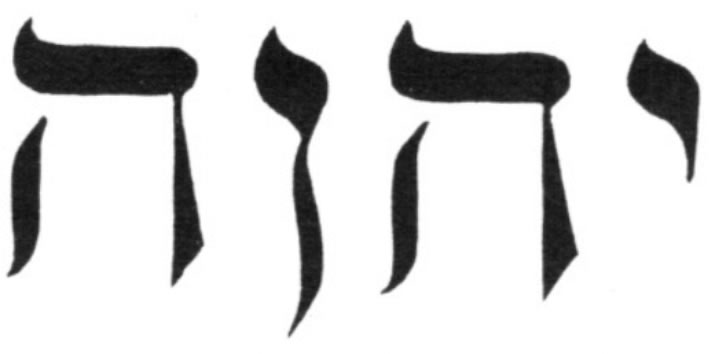
1. In the Old Testament book of Exodus, Chapter 6,
verse 3, the prophet Moses, while conversing with the Lord, was told the
following:
And I appeared unto Abraham,
unto Isaac, and unto Jacob,
in
El-Shaddai [God Almighty],
and was my name YHWH [Jehovah]
not known unto them?
2. Thus the sacred 4-letter name (usually referred
to by it’s Greek-origin name), “Tetragrammaton”, was recorded and passed down.
However, in Genesis the name was already used, as early as Genesis chapter 2,
verse 5.
3. There is a peculiar feature of scriptural
records-keeping, namely, that the ancient Jews tended not to transmit the
Tetragammaton into translations of the scriptures, instead opting for a
modification or outright translation.
4. Fancy this: The earliest Jewish translations of
the scriptures, the Targumim (translations from Hebrew to Aramaic), rendered
YHWH as “Lord Jah”, מריא, “MarYah”. Given that “Yah”, (usually written “Jah” in English),
is the well-known short form of YHWH, this first treatment of the Tetragrammaton
in translation transmitted at least a form of YHWH. The Aramaic-speaking
Christians preserved the title “Mar-Yah” in their New Testament, which in and
of itself is a topic worthy of every Monotheist’s attention (Luke 2:11):
For unto you is born this
day
in the city of David a
Savior,
which is the Messiah the
Lord Jah (Jehovah).
5. However, after the Targumim ‘translations’ (from
Hebrew to Aramaic), the Jews began treating the name YHWH more as a title to be
translated than as a name that should be transmitted, even partially.
6. In approximately 200 B.C. Jewish scribes in
Alexandria translated their scriptures (essentially the Old Testament) to
Greek, and here the Tetragrammaton was rendered Κύριοσ,
“Kirios” or “Lord” (with a capital “L”). This tradition is preserved somewhat
in the King James Version of the Bible, where YHWH in the Old Testament is in
all capital letters as LORD, but Lord in the New Testament.
7. The Sephardic Jews preserve this translation of
YHWH as “Lord” as well. In their translations YHWH is “על סינניור” “El Siñor”, ‘the Lord’.
8. The European Jews translated YHWH as “the
Eternal (One)”:
a.
French: l’Éternel
b.
German: der Ewige
c.
Spanish: el Eterno
9. What caught my attention recently was the possible
translation of YHWH in the Qur’an. First consider Deuteronomy 6:4:
Listen ye, O Israel! YHWH our God
is One YHWH.
Now consider Isaiah 44: 6
Thus saith YHWH, King of Israel,
and His Savior, YHWH of Hosts,
I am the Beginning, and I am the Last,
and
except by Me there is no God (literally “Elohim”).
10. Now, consider this most beautiful verse from the
Qur’an, Surah II:255:
O God! There is no god
except Him, the Life-the Eternity
(al-HayyulQayyuum)…
11. It is said that of the 99 names/titles of God in
the Quran, this one is the most sacred. It is interesting how the phrasing
recalls Deuteronomy and Isaiah, and the title, “the Life-the Eternity” is very
close to the manner in which many Jewish communities have translated the sacred
Tetragrammaton to their native languages. Might Surah II: 255 preserve a
Jewish-Arabic translation of the Tetragrammaton? In my musings, I favor such a
view.
12. However, I will round out my musings on this
point, that the alphabet we consider to be quintessentially Jewish, the Hebrew
alphabet, was Babylonian in origin, and the Jews, during their captivity in
Babylon, adopted the Babylonian (a.k.a. “Assyrian” alphabet) as their own.
Eventually the Jews abandoned their original alphabet altogether. Nowadays few
people know or are interested in the fact that after 600 B.C. the Jews adopted
a new alphabet and transcribed the scriptures from their original script into this essentially Gentile alphabet, an alphabet that over time came to be Jewish after even its Babylonian inventors abandoned it.
13. So what was the
original alphabet of the Israelites? Today it is known as “Paleo-Hebrew”, and
it bore some resemblance to Egyptian hieroglyphics:

14. Now, we might think that an alphabet is an
alphabet. That may be. However, the Paleo-Hebrew letters, besides functioning
to represent sounds, still retained some of their pictographic meanings. That
is to say, the individual Paleo-Hebrew letters still could be used or
interpreted to convey ideas that their source-language pictograms (or hieroglyphs)
once carried.
15. So for the Hebrews, the most sacred name in
scripture was YHWH, the Tetragrammaton. Did the Tetragrammaton carry any
particular meaning in its original Paleo-Hebrew letters? I say, decide this one
for yourselves:
Starting from the right side and
move to the left:
a.
Yod: Arm in right angle with closed hand.
b.
He: Behold!
c.
Waw: Nail, fixed, sure in position.
d.
He: Behold!
16. The Paleo-Hebrew Tetragrammaton, the spelling of
the sacred name YHWH (Jehovah) in its pre-600 B.C., pre-Babylonian captivity, in its original Israelite spelling, which is very possibly the text used by Moses himself when
he recorded five sacred books (at least), the sacred Tetragrammaton meant:
Behold the Hand!
Behold the Nail!
17. And the nail could not have been in the palm, as
the hand is closed, and the nail was understood by the Israelites to be fixed
in place securely.
18. I will leave the reader to decide what, if
anything, to make of this information, but remember this: This is actually
textual.
